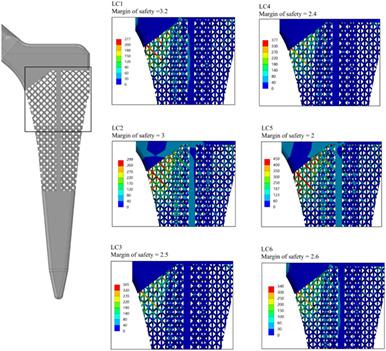当前位置:
X-MOL 学术
›
Int. J. Numer. Method. Biomed. Eng.
›
论文详情
Our official English website, www.x-mol.net, welcomes your feedback! (Note: you will need to create a separate account there.)
Structural analysis of an endoprosthesis designed with graded density lattice structures
International Journal for Numerical Methods in Biomedical Engineering ( IF 2.1 ) Pub Date : 2020-11-28 , DOI: 10.1002/cnm.3420 Vadim Sh Sufiiarov 1 , Evgeniy V Borisov 1 , Viktoriya V Sokolova 1 , Mariya O Chukovenkova 2 , Alexanser V Soklakov 2 , Dmitry S Mikhaluk 2 , Anatoliy A Popovich 1
International Journal for Numerical Methods in Biomedical Engineering ( IF 2.1 ) Pub Date : 2020-11-28 , DOI: 10.1002/cnm.3420 Vadim Sh Sufiiarov 1 , Evgeniy V Borisov 1 , Viktoriya V Sokolova 1 , Mariya O Chukovenkova 2 , Alexanser V Soklakov 2 , Dmitry S Mikhaluk 2 , Anatoliy A Popovich 1
Affiliation

|
The most common causes of conducting a hip revision surgery after total hip replacement are aseptic loosening (aseptic instability) of the endoprosthesis, bone destruction as a result of contact with the endoprosthesis, and a periprosthetic fracture. These are the effects of load transfer to the bone tissue in arthroplasty resulting due to the difference in stiffness of the endoprosthesis and the bone. Titanium alloy is widely used in endoprostheses manufacturing because of its high biocompatibility, good wear properties, and corrosion resistance, but such endoprostheses are stiffer than the femur. These problems have raised interest in searching for the best materials and topology for a femoral implant. Nowadays additive technology is of great interest as it enables to create materials with graded density. These materials consist of multiple lattice structures with variable parameters and topology. By varying the parameters of lattice structures one can adjust the mechanical properties of the material as required. These materials find their application in hip endoprostheses manufacturing, allowing to adjust the parameters of the lattice structures, and deliver a product with femur‐like mechanical properties. The porous structure also ensures bone tissue ingrowth into the prosthesis. The authors designed and simulated an endoprosthesis made of graded density lattice structures with femur‐like mechanical properties. Using a numerical simulation software Ansys Mechanical authors determined the effect of the topology on the structural behavior of the femur and defined the endoprosthesis‐femur combined performance under various load cases.
中文翻译:

用梯度密度晶格结构设计的内置假体的结构分析
在全髋关节置换术后进行髋关节翻修手术的最常见原因是假体无菌性松动(无菌性不稳定)、与假体接触导致的骨质破坏以及假体周围骨折。这些是关节置换术中由于内置假体和骨骼的刚度不同而导致的向骨组织转移的影响。钛合金因其高生物相容性、良好的耐磨性和耐腐蚀性而被广泛用于制造假体,但这种假体比股骨更硬。这些问题引起了人们对寻找股骨植入物的最佳材料和拓扑结构的兴趣。如今,添加剂技术引起了极大的兴趣,因为它能够制造具有梯度密度的材料。这些材料由多个具有可变参数和拓扑结构的晶格结构组成。通过改变晶格结构的参数,可以根据需要调整材料的机械性能。这些材料在髋关节假体制造中得到了应用,可以调整晶格结构的参数,并提供具有类似股骨机械性能的产品。多孔结构还确保骨组织向内生长到假体中。作者设计并模拟了一种由梯度密度晶格结构制成的内置假体,具有类似股骨的机械性能。使用数值模拟软件 Ansys Mechanical,作者确定了拓扑结构对股骨结构行为的影响,并定义了各种负载情况下的内置假体-股骨组合性能。
更新日期:2020-11-28
中文翻译:

用梯度密度晶格结构设计的内置假体的结构分析
在全髋关节置换术后进行髋关节翻修手术的最常见原因是假体无菌性松动(无菌性不稳定)、与假体接触导致的骨质破坏以及假体周围骨折。这些是关节置换术中由于内置假体和骨骼的刚度不同而导致的向骨组织转移的影响。钛合金因其高生物相容性、良好的耐磨性和耐腐蚀性而被广泛用于制造假体,但这种假体比股骨更硬。这些问题引起了人们对寻找股骨植入物的最佳材料和拓扑结构的兴趣。如今,添加剂技术引起了极大的兴趣,因为它能够制造具有梯度密度的材料。这些材料由多个具有可变参数和拓扑结构的晶格结构组成。通过改变晶格结构的参数,可以根据需要调整材料的机械性能。这些材料在髋关节假体制造中得到了应用,可以调整晶格结构的参数,并提供具有类似股骨机械性能的产品。多孔结构还确保骨组织向内生长到假体中。作者设计并模拟了一种由梯度密度晶格结构制成的内置假体,具有类似股骨的机械性能。使用数值模拟软件 Ansys Mechanical,作者确定了拓扑结构对股骨结构行为的影响,并定义了各种负载情况下的内置假体-股骨组合性能。



























 京公网安备 11010802027423号
京公网安备 11010802027423号